Education Corner
Interactive RNA Education with the Eterna Game
By Jill Townley
Eterna is an online game which models the base pairing and secondary structure of RNA sequences.
The game was created by Rhiju Das (Stanford University) and Adrien Treuille (Carnegie Mellon University) in 2011 after the pair met while postdocs in the Baker Lab (University of Washington) working on the protein modeling game Foldit [1]. People around the world visit the game website daily to play RNA folding puzzles and submit RNA sequences in "lab puzzles" that go on to be tested experimentally by academic researchers [2-4].
Although primarily a participatory science platform, teachers have taken advantage of the game's 30 tutorial puzzles to introduce RNA secondary structure concepts to their high school and college biology students. The five series of tutorial puzzles typically take five hours to complete. For younger students, PBS Nova's RNA VirtualLab is powered by an Eterna folding engine and features animated videos of protein synthesis and viral infection in the cell.

In 2021, Eterna added a feature that displays a 3D model of RNA structures using PDB files from the RCSB Protein Data Bank and other sources. The 3D structure of the Azoarcus ribozyme recently was featured in a lab puzzle for an ESPCI-Paris project exploring the RNA world hypothesis. The lab puzzle also demonstrated the improved pseudoknot prediction capabilities offered by RibonanzaNet-SS [5], developed by the Das Lab with help from the player community.
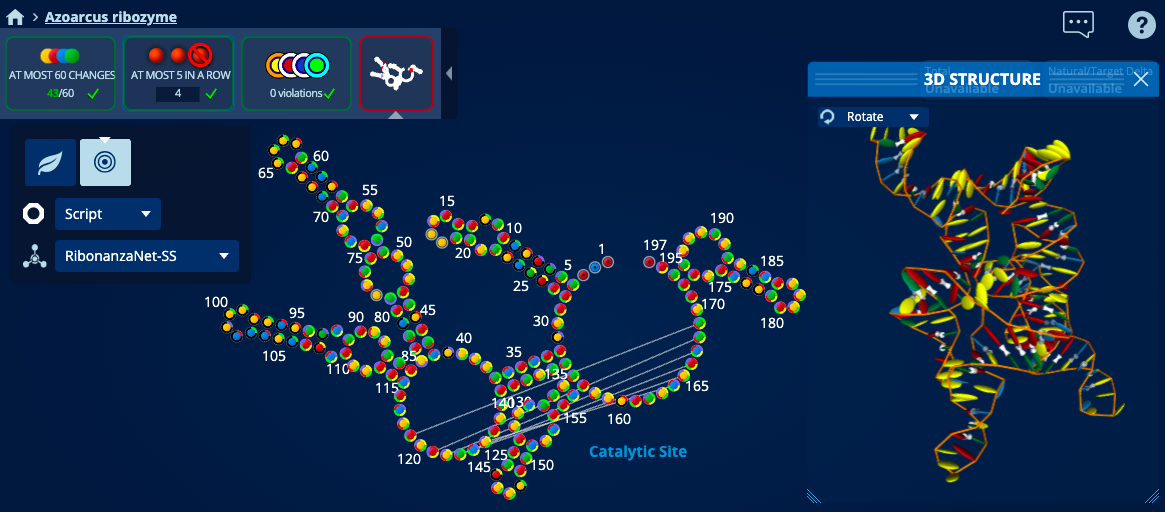
Coursera
In 2023, the Center for Genetically Encoded Materials (C-GEM) partnered with Eterna to create two modules for a Coursera course titled "RNA Biology with Eterna". The course is free and intended for biochemistry students. Module 1 introduces the chemical forces driving base pairing and common structural motifs, and ends with a video demonstrating the preparation of a library for sequencing and chemical mapping. Module 2 covers the Central Dogma and how scientists are rewriting the rules to synthesize advanced polymers. The closing video explains 3D model generation from cryo-EM.
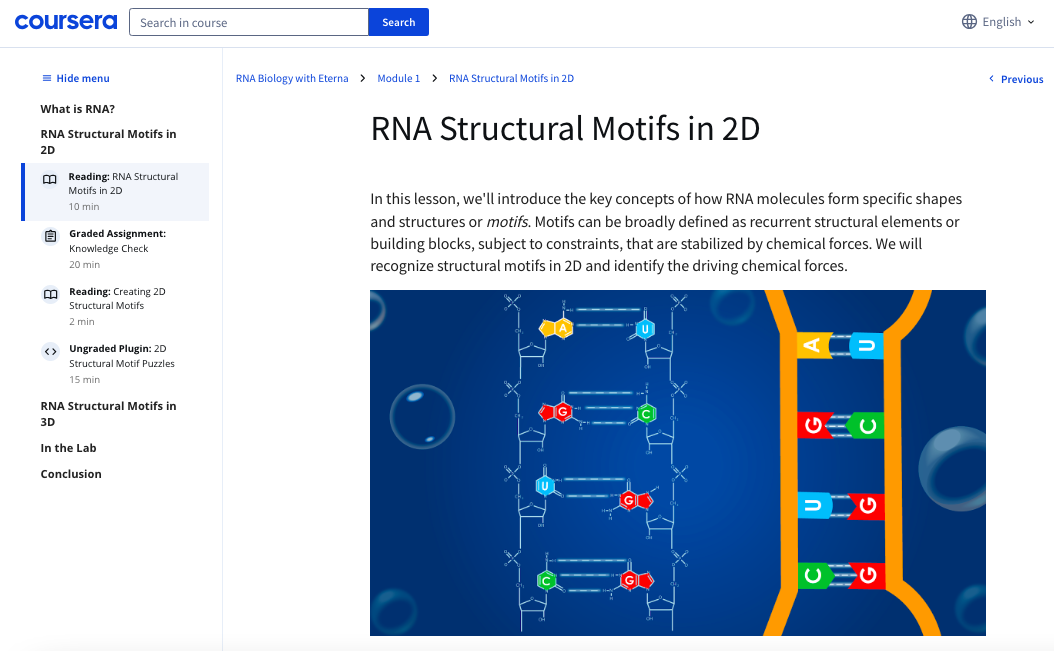
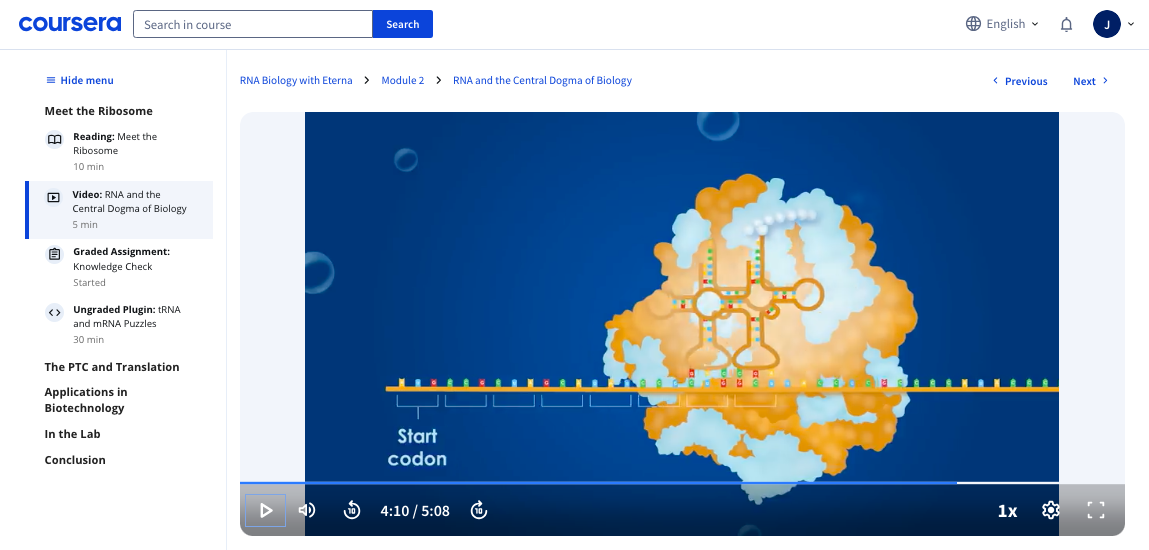
The modules are divided into lessons with illustrated text, explainer videos, knowledge checks, and Eterna puzzles demonstrating concepts such as free energy, pseudoknots, the tRNA anticodon, codon frequency, and the peptidyl transferase center. One of the puzzles even features the well-known drug Ozempic.

One of the student beta testers reported Eterna puzzles were “one of my favorite parts of this course; it allowed me to apply my knowledge in a meaningful way."
EternaDemo app for STEM outreach
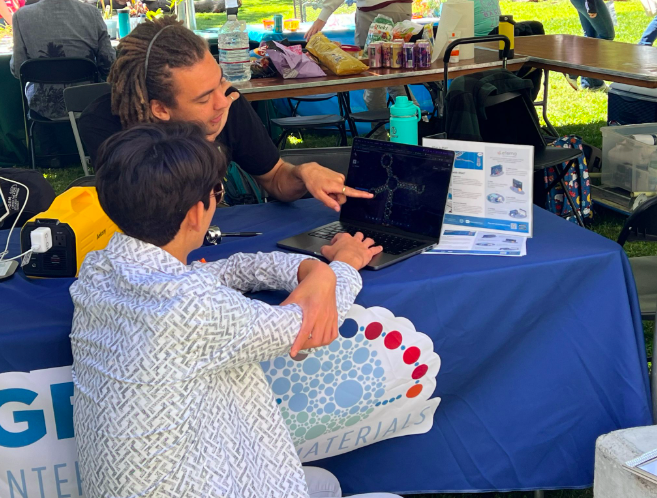
For educators who want to do community outreach, the EternaDemo app is a lightweight version of the game that can be loaded on iPads and shared with the general public at science festivals and STEM day exhibits. The suggested hairpin puzzle is simple enough for both children and adults to solve in two minutes while learning about the four nucleotides and pairing strength. Educators can load additional puzzles that demonstrate 3D structures, specific topics, or just more complexity.
Example posters, handouts, stickers, and 3D print files are provided as part of the EternaDemo kit. The kit can be accessed through the For Educators menu on Eterna's website.
References
- Markov, J. RNA Game Lets Players Help Find a Biological Prize. New York Times D.4 (11 January 2011).
- Krüger, A., Watkins, A.M., Wellington-Oguri, R. et al. Community science designed ribosomes with beneficial phenotypes. Nat Commun 14, 961 (2023). https://doi.org/10.1038/s41467-023-35827-3
- Wayment-Steele, H.K., Kladwang, W., Watkins, A.M. et al. Deep learning models for predicting RNA degradation via dual crowdsourcing. Nature Machine Intelligence 4, 1174–1184 (2022). https://doi.org/10.1038/s42256-022-00571-8
- J.O.L. Andreasson, M.R. Gotrik, M.J. Wu et al. Crowdsourced RNA design discovers diverse, reversible, efficient, self-contained molecular switches, Proc. Natl. Acad. Sci. U.S.A. 119 (18) e21129791 (2022). https://doi.org/10.1073/pnas.2112979119
- Shujun He, Rui Huang, Jill Townley et al. Ribonanza: deep learning of RNA structure through dual crowdsourcing. bioRxiv 2024.02.24.581671; doi: https://doi.org/10.1101/2024.02.24.581671
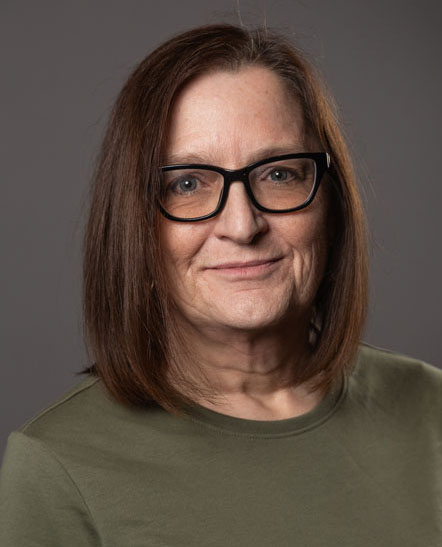
Jill Townley began playing Eterna in 2017 and joined the development team in 2021. She currently leads research coordination, which involves creating the lab puzzle for the researchers and distilling scientific concepts for the players. If your lab would like to learn more about collaborating with Eterna, contact jill@eternagame.org.
